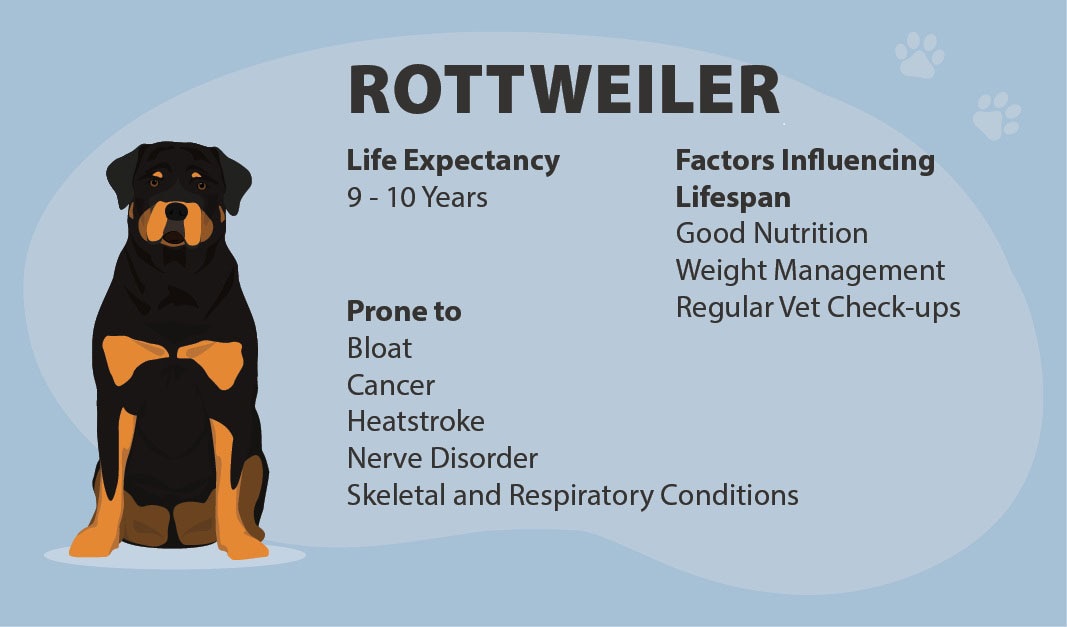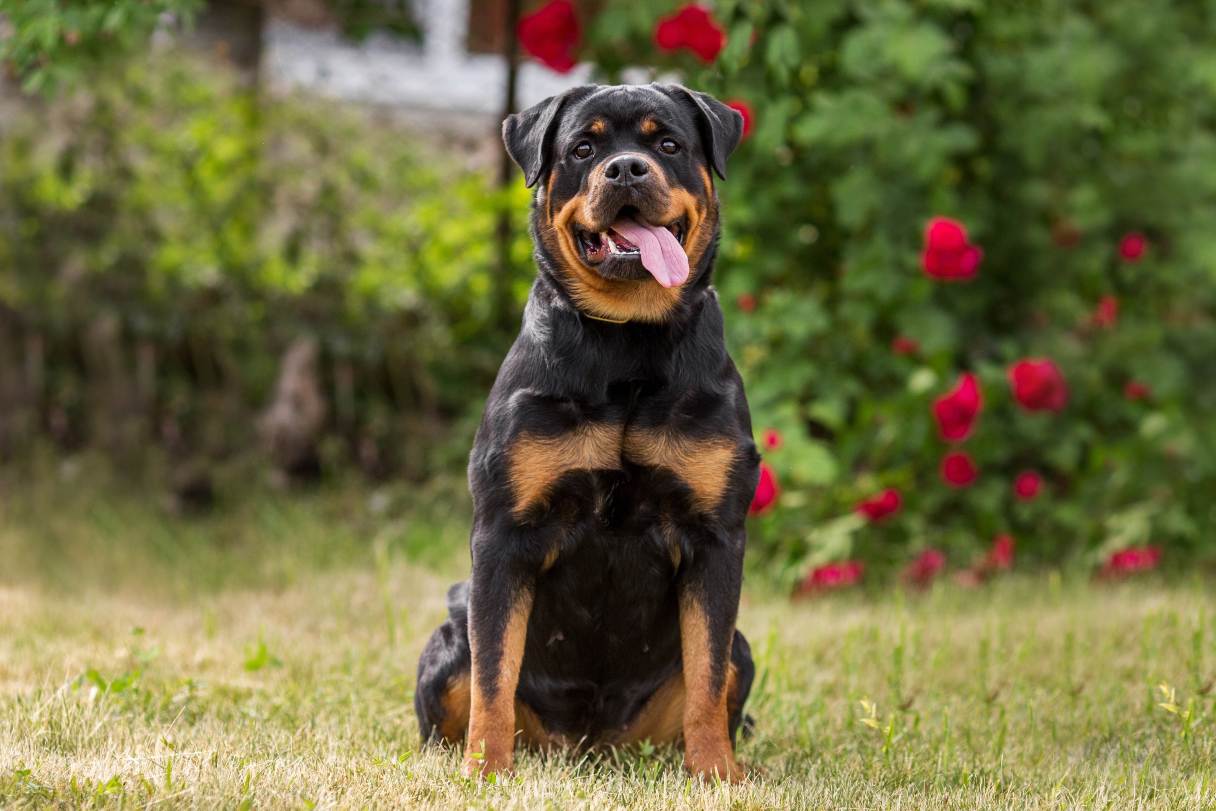Rottweilers might look like the canine equivalent of someone who'd rough you up and take your lunch money, but like many mastiff breeds, a gentle sweetness and playful sense of humor undergirds their brutish demeanor. While they can indeed be employed as effective guardians and protectors, this ancient working-class breed is affectionate and loyal and loves to stay busy.1
Continue reading to learn more about rottweilers, including their temperament, healthcare needs and what they're like to live with.
About the Rottweiler
The rottweiler — rottie for short — is a very old dog breed that’s descended from a downright ancient one. It was the Roman legions who developed the European mastiff that became the ancestor of several modern mastiff breeds, including the rottweiler. Employed as drover dogs, which moved livestock from one place to another, this particular line of mastiffs was employed in the German town of Rottweil to help move cattle to market. They became known as "Rottweiler Metzgerhund" — Butcher’s Dog of Rottweil.1
After the railroad ended the need to move cattle herds long distance on foot, rotties were employed as police dogs, guard dogs and all-around working dogs. They were even one of the first breeds to be used as Seeing Eye® dogs. Today, rotties are a popular breed for search and rescue. Despite their ancient lineage, it wasn’t until 1901 that the first rottweiler breed standard was developed.1
Rottweiler Appearance

The American Kennel Club (AKC)’s breed standard describes the ideal rottweiler as “robust and powerful.”2 Males weigh 95 to 135 pounds and stand up to 27 inches at the shoulder.1 The somewhat smaller females weigh 80 to 100 pounds and get as tall as 25 inches.1
Rotties are muscular dogs with broad, deep chests and straight, strong backs.2 Traditionally, the tail has been docked to two inches in length, but undocked tails are acceptable and are set slightly upward from the back, carried either straight or curving upward.2 The American Veterinary Medical Association opposes tail docking for cosmetic purposes and has called for this practice to be removed from breed standards.3
The head is broad, with a slightly arched forehead when viewed in profile; a wide muzzle sporting a strong set of jaws; triangle-shaped ears that hang alongside the head; and an alert, confident face. The medium-length coat is flat and coarse, colored black with the distinctive rust-colored markings on the face, chest and legs that make this breed instantly recognizable.2
Rottweiler Temperament
Around strangers, rottweilers present as aloof but alert and confident guardians of their people and territory. But at home with their humans, rotties turn into silly, playful cuddle bugs that can’t be convinced they don’t belong in your lap. They’re extremely loyal dogs that love to be with their people and aren’t meant to be left on their own.1
While rottweilers are generally very sweet and loving with their people, they’re also highly protective of them, which can lead to aggression toward perceived threats. A rottie that's well trained and socialized will likely rely on barking and intimidation, rather than biting, to corner someone they see as a danger, but this could still lead to awkward situations with neighbors who aren’t prepared for it. You should also make sure your rottie is well acquainted and on good terms with any pet sitters or caregivers you plan to leave them with.4
Rotties are intelligent and easy to train, although they can be a bit willful, and some have been known to try to bully or bluff their owners.4 From an early age, they need lots of socialization and positive training from an assertive and patient leader.4 But they can learn commands quickly and, overall, rotties want to make their people happy.4 Early socialization and consistent training throughout their lives can overcome any aggressive tendencies and harness their territorial and protective instincts for good.1
Rottweilers are a big commitment in terms of space, time and energy. As wonderful as these dogs can be for the right owners, they’re definitely not for everyone. Before deciding to get one of these lovable giants, you and your family should assess whether you have what it takes to meet this breed’s extensive training, socialization and exercise needs. If you’re up to the challenge, the bond you’ll forge with your rottie will be priceless.4
Living With Rottweilers
Thinking about getting a rottweiler? A rottie needs an active owner who can match their energy and who has enough time each day to devote to their training, exercise and mental enrichment. Here's more about what it's like to live with and care for a member of this breed, along with tips for a happier, healthier life.
Who they're best for
Rotties need someone who is assertive enough to command their respect. Also, these dogs are big and strong. While many women have success with rottweilers, kids and older adults shouldn’t be expected to handle these dogs on their own.4
This breed can get along well with children and can make excellent protectors. But due to their size and strength, their interactions should be supervised. Rotties generally aren’t recommended for homes with small children. Their leaning and herding tendencies have been known to inadvertently cause injuries.4
And make no mistake — rotties are heavy leaners. Thought to be a holdover from their cattle-herding days, they now mostly do it to show affection. But rotties can knock a small or frail person over if they’re not prepared to get leaned on by 100 pounds of dog muscle.5
Living space
Rottweilers are best suited to homes with large yards and tall, sturdy fences. These large dogs can adapt to spacious apartments, but without a yard, you’ll have your work cut out for you keeping them sufficiently walked and exercised. These aren’t dogs that should be allowed to wander on their own, even in rural areas, due to their territoriality and protective instincts.4
A rottweiler that joins a home as a puppy can learn to get along well with existing pets. However, adding a new pet to a home where a rottie is already established can be a challenge, as can bringing in a new rottie that's already grown. While some of these dogs may show aggression toward other dogs, each rottie is different in this regard. Caution, and a lot of research, are recommended when it comes to introducing a mature rottie to new-to-them pets.4
Exercise and activity
Above all, rottweilers are highly driven working dogs who are most content when they have a job to do. If you don’t have livestock for them to help manage or property for them to guard, their excessive energy and work drive can be channeled into dog sports like tracking and obedience.1 Without positive outlets for their energy, your rottie might get bored and resort to destructive behavior.4
Grooming
Rottweilers are relatively low-maintenance when it comes to grooming. They have a double coat that sheds heavily twice a year, during which times they’ll need daily brushing to keep it under control. But weekly brushing is all that’s needed the rest of the year, along with periodic baths. Nails need to be trimmed regularly, and a Dremel tool is generally recommended over the use of nail clippers. Regular toothbrushing will help keep teeth and gums healthy in between veterinary dental cleanings.1
Rottweiler Health and Life Expectancy

The average life expectancy for a rottweiler is nine to 10 years.1 But good nutrition, healthy weight management and regular vet checkups can go a long way toward helping your rottie live a long and healthy life.
Rottweilers should be fed high-quality dog food that’s appropriate to their current life stage.1 Look for food with a nutritional profile that’s been approved by the Association of American Feed Control Officials (AAFCO).6 Also, to support the growth and maintenance of large bones, seek out dog and puppy food that’s been specially formulated for large breeds.6
It’s important to keep your rottie at a healthy weight to help prevent joint problems and other health issues as they age.6 Measure their food according to directions and keep treats to a minimum.1 You might consider giving them dog-safe, low-calorie fruits and veggies in place of high-calorie commercial dog treats.
Despite even the best preventive care, rottweilers may still face some hereditary health issues that are common to the breed. Bear in mind that responsible breeders do their best to screen for these conditions and reduce their likelihood of occurring.1 Nevertheless, health issues may include the following:
Bloat
As a large, deep-chested breed, rotties are susceptible to gastric dilatation-volvulus complex, more commonly known as bloat. This is a critical condition in which the stomach becomes distended with gas and twists on itself. Feeding two or three small meals a day can help reduce the chances of developing this potentially life-threatening condition.7
Hip dysplasia
With hip dysplasia, a common condition in large breed dogs, the hip bone doesn't fit properly into the hip socket. It's painful and can lead to osteoarthritis down the line, but it may be treatable with surgery or nutrition and lifestyle changes.8
Laryngeal paralysis
This is a condition in which the nerves of the voice box muscles are weakened, causing the cartilage to collapse and resulting in vocal cord paralysis. Mild cases are typically managed with medication, and surgery may help in severe cases.9
Polyneuropathy
A genetic condition specific to rottweilers, distal polyneuropathy is marked by weakness on one side of the body that eventually spreads to all four legs. While some cases can be managed for a while with corticosteroids, the prognosis for dogs with this condition is generally poor.10
Cancer
Rottweilers may also be prone to developing cancer. However, research has shown that delaying spaying and neutering until rotties are 6 years old, along with vaccinating to promote a strong immune system, can help increase longevity in rottweilers. Be sure to talk to your vet about vaccinations and the best age to spay or neuter your rottie.1
Heatstroke
Thanks to their thick, black coats and shorter snouts, rottweilers are prone to overheating. They need extra care in the summer and in warm climates to help them stay cool and avoid heatstroke. Rotties shouldn’t be left outside without plenty of shade, and they should never be left in the car alone.4
Buying or Adopting a Rottweiler
The cost to buy a registered rottweiler puppy from a reputable breeder ranges from $1,200 to $3,500 and up. This price range is influenced by many factors, including your location and whether the parents are from a championship line.11
Rottweilers and rottie mixes of all ages can be found at animal shelters and pet rescues. Adopting a rottweiler from a rescue will likely cost between $250 and $600, depending on your location, the age of the dog and whether it has any special needs.12
A list of reputable rottweiler rescue organizations across the United States can be found at the Rottweiler Rescue Foundation.
CareCredit Credit Card Financing for Dogs
Taking good care of your pet's well-being from nose to tail is essential. Make sure to stay up to date on their regular checkups at the vet to help keep your pet happy and healthy for a lifetime of love. You can use your CareCredit credit card for pet care throughout the year for routine veterinary services as well as emergencies and surgeries.* Use our Acceptance Locator to find a veterinarian near you that accepts CareCredit.
CareCredit is there for you and your pet every step of the way; continue your wellness journey by downloading the CareCredit Mobile App to manage your account, find a provider on the go and easily access the Well U blog for more great articles, podcasts and videos.
In addition to pet care, you can also use your CareCredit credit card for dentistry, cosmetic, vision, hearing, health systems, dermatology, pharmacy purchases, spa treatments and so much more within the CareCredit network. How will you invest in your health and wellness next?
Author Bio
Jean Marie Bauhaus is a freelance writer and novelist who has been writing pet content since 2013. Her work has appeared on Forbes.com, Hill's Pet, Chewy, AKC.org and more.







